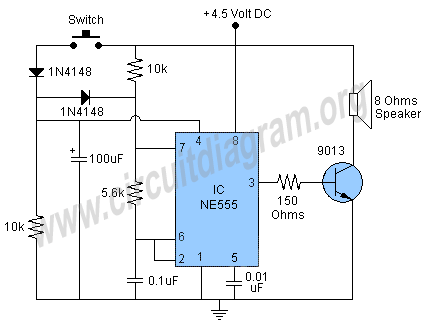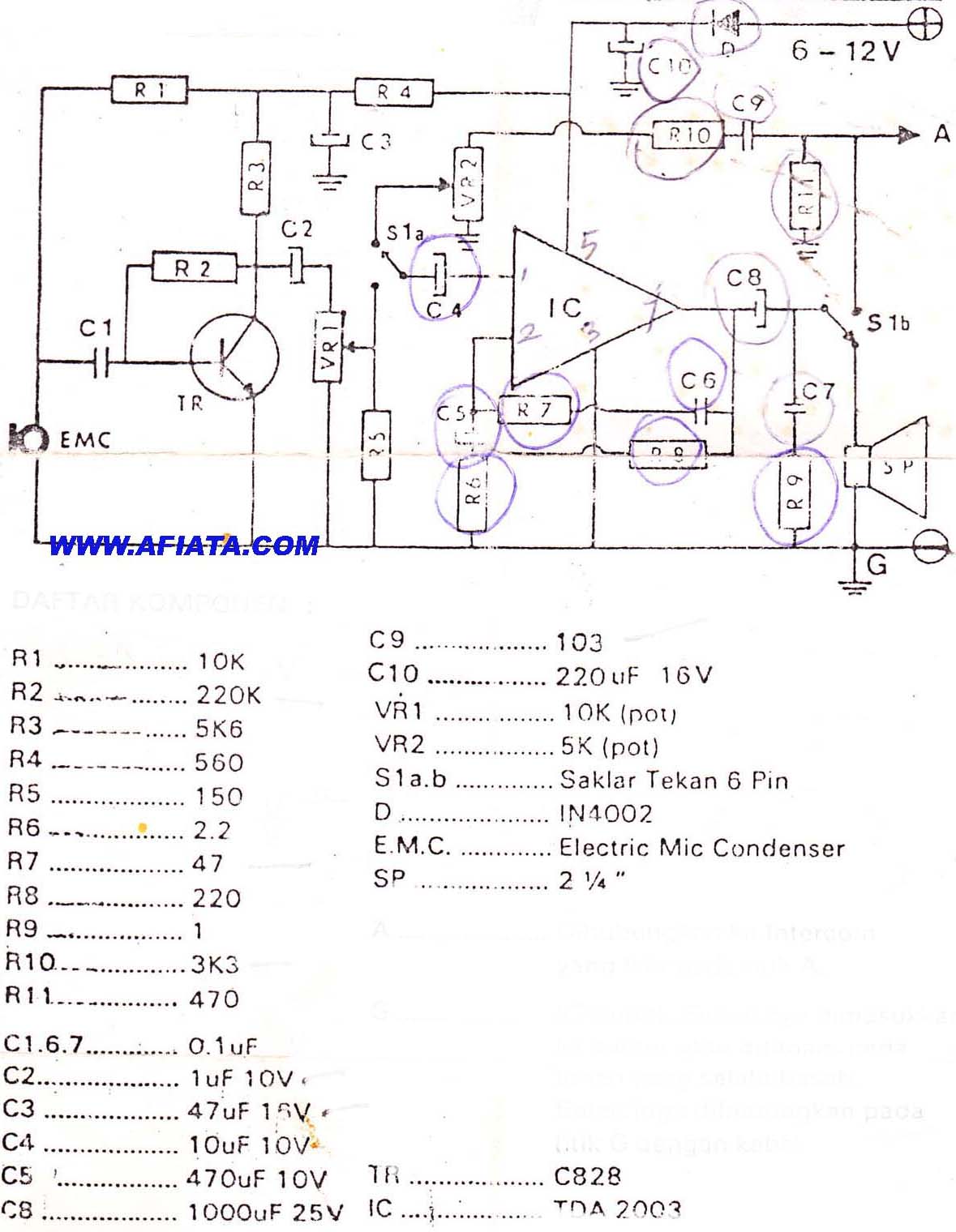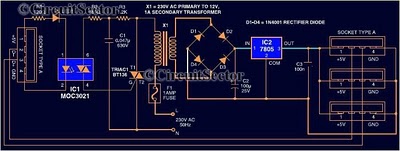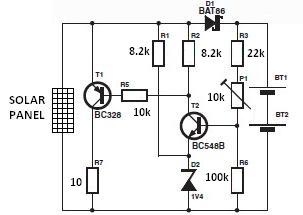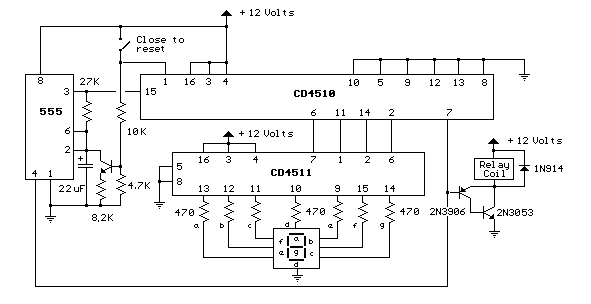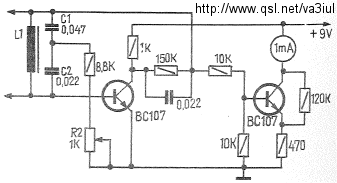
Digital circuit strain with MAX1494
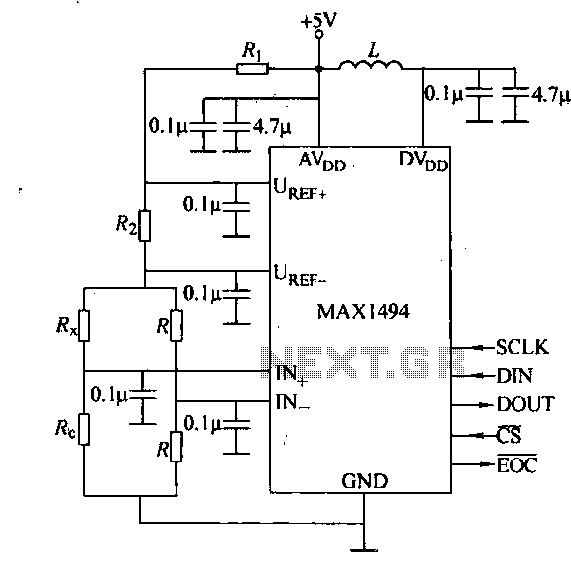
The circuit consists of the MAX1494 digital strain gauge, as illustrated in Figure 5-31. It includes a bridge formed by resistance strain gauges and a temperature compensation sheet. The standard quasi-resistance values Rl and R are incorporated into the circuit. The bridge voltage is supplied by the internal reference voltage of the MAX1494, which also serves as the differential input termination for the strain bridge output voltage, with a voltage range of 200 mV to 2 V.
The MAX1494 is a highly integrated digital strain gauge interface designed to measure strain by using a bridge configuration of resistive strain gauges. The strain gauges convert mechanical deformation into a change in resistance, which is then translated into a voltage signal. The internal reference voltage provided by the MAX1494 is critical for ensuring accurate measurements, as it stabilizes the voltage across the bridge and allows for precise differential measurements.
In this circuit, the bridge is typically formed by four strain gauges arranged in a Wheatstone bridge configuration. This arrangement allows for the detection of small changes in resistance due to strain, enhancing sensitivity and accuracy. The temperature compensation sheet is essential for minimizing the effects of temperature variations on the strain gauge readings, ensuring that the measurements reflect only the mechanical strain.
The output voltage of the bridge, which varies between 200 mV and 2 V, is fed into the differential input of the MAX1494. This voltage range is suitable for various applications, including structural health monitoring, load cells, and pressure sensors. The MAX1494's internal circuitry amplifies and digitizes the analog signal from the strain bridge, providing a digital output that can be easily interfaced with microcontrollers or other digital systems for further processing and analysis.
In summary, the circuit utilizing the MAX1494 digital strain gauge is a robust solution for measuring strain with high precision, leveraging the advantages of a bridge configuration, temperature compensation, and digital signal processing capabilities.Circuit constituted by the MAX1494 digital strain gauge shown in Figure 5-31. See the bridge by the resistance strain gages, temperature compensation sheet R, standard quasi resistance Rl and R l trespassing into. Bridge voltage provided by the MAX1494's internal reference voltage, MAX1494 differential input termination strain bridge output voltage, the voltage range of soil 200mV- 2V.
The MAX1494 is a highly integrated digital strain gauge interface designed to measure strain by using a bridge configuration of resistive strain gauges. The strain gauges convert mechanical deformation into a change in resistance, which is then translated into a voltage signal. The internal reference voltage provided by the MAX1494 is critical for ensuring accurate measurements, as it stabilizes the voltage across the bridge and allows for precise differential measurements.
In this circuit, the bridge is typically formed by four strain gauges arranged in a Wheatstone bridge configuration. This arrangement allows for the detection of small changes in resistance due to strain, enhancing sensitivity and accuracy. The temperature compensation sheet is essential for minimizing the effects of temperature variations on the strain gauge readings, ensuring that the measurements reflect only the mechanical strain.
The output voltage of the bridge, which varies between 200 mV and 2 V, is fed into the differential input of the MAX1494. This voltage range is suitable for various applications, including structural health monitoring, load cells, and pressure sensors. The MAX1494's internal circuitry amplifies and digitizes the analog signal from the strain bridge, providing a digital output that can be easily interfaced with microcontrollers or other digital systems for further processing and analysis.
In summary, the circuit utilizing the MAX1494 digital strain gauge is a robust solution for measuring strain with high precision, leveraging the advantages of a bridge configuration, temperature compensation, and digital signal processing capabilities.Circuit constituted by the MAX1494 digital strain gauge shown in Figure 5-31. See the bridge by the resistance strain gages, temperature compensation sheet R, standard quasi resistance Rl and R l trespassing into. Bridge voltage provided by the MAX1494's internal reference voltage, MAX1494 differential input termination strain bridge output voltage, the voltage range of soil 200mV- 2V.
Warning: include(partials/cookie-banner.php): Failed to open stream: Permission denied in /var/www/html/nextgr/view-circuit.php on line 713
Warning: include(): Failed opening 'partials/cookie-banner.php' for inclusion (include_path='.:/usr/share/php') in /var/www/html/nextgr/view-circuit.php on line 713
